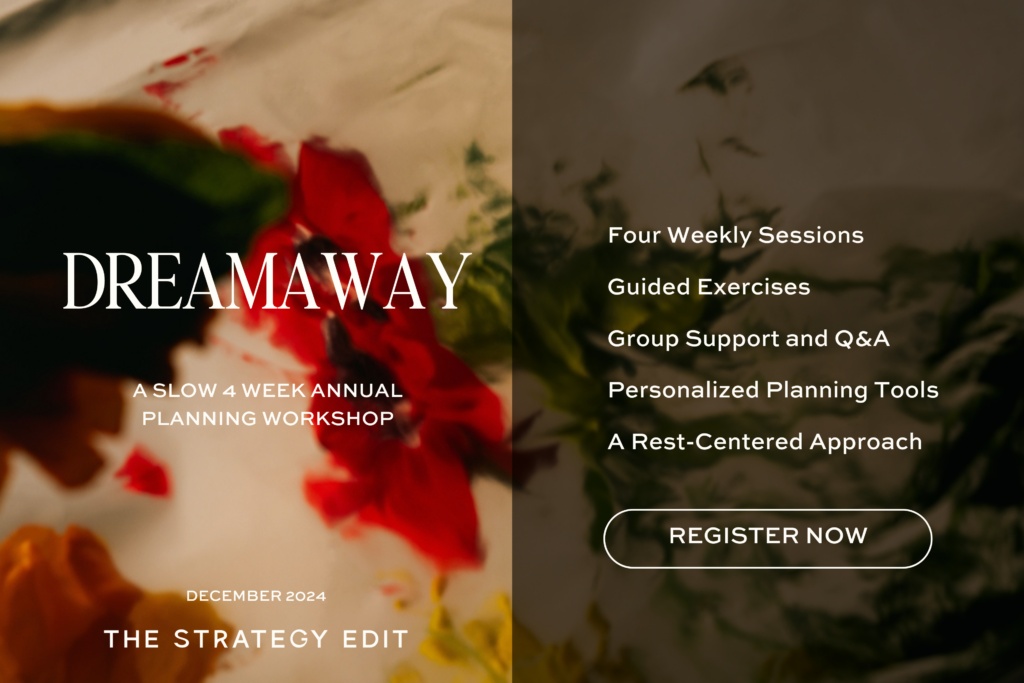
As we start gearing up for the end of Q4, it’s the perfect time to dive into 2025 annual planning that’s both purposeful and sustainable. My approach isn’t about squeezing every drop of productivity out of the year; it’s about setting yourself up with a plan that feels intentional, fulfilling, and achievable.
I’ll walk you through my four-step process — Reflect, Dream, Plan, and Implement — to help you create a meaningful roadmap for the year ahead. Here’s how to kickstart your journey with clarity, creativity, and plenty of room for rest.
🎧 For even more insight, check out the podcast!
I’ve created a two-part podcast mini-series to walk you through each phase of 2025 annual planning — from reflecting on the past year to setting sustainable goals. Listen to Part 1 and Part 2 below to dive deeper into each step.

Step 1: Reflect on 2024
Reflecting on the past year is essential for setting up a meaningful year ahead. I find that giving this step the time it deserves can lead to some surprising insights.
- Set the Mood: Create a cozy, distraction-free environment. I like to light a candle, pour a yummy drink, and put on play a playlist I love. Making this a ritual helps me focus and enjoy the process. I always aim to set aside an hour or two for the reflection stage.
- Gather Your Sources: Open your calendar, grab a notebook, and pull up your favorite photos. Look back over your 2024 meetings, events, milestones, and even the small moments that mattered. Consider both personal and professional experiences to get a well-rounded view.
- Compile Your List
- Starting with January, work your way through your calendars, CRM systems, financial statements, photo albums on your phone, etc. to compile the standout things that happened each month
- Review your list and highlight the significant things that occurred throughout the year
- Ask Yourself Three Questions:
- What went well? Write down the wins — big or small — and celebrate them.
- What could be improved? Consider what didn’t work as planned. No need for judgment, just awareness.
- What am I leaving behind? This might include habits, thoughts, or activities that no longer serve you.
- Focus on Progress, Not Perfection: Reflecting back should help you see your journey. Don’t just focus on how far you have left to go — look at how far you’ve come. For me, looking at where I started versus where I am now helps me appreciate the journey.

Step 2: Dream About 2025
Once you’ve absorbed the lessons of 2024, it’s time to let your imagination run wild. The dreaming phase is all about envisioning what you want 2025 to feel and look like in your ideal world.
- Visualize the End of 2025: Imagine it’s December 31, 2025. Walk yourself through each area of life — career, personal relationships, health, finances, and growth. Try to be specific about what you see. What’s happening? How do you feel?
- Define the Core Emotions: Name the feelings that come up as you envision this ideal year. Words like peace, joy, security, and fulfillment are often what we’re really chasing. Write down what comes up; they’ll serve as a compass for everything you do in 2025.
- Anchor Those Feelings Now: Instead of waiting for some big milestone, start bringing those core emotions into your daily life. If security is one of them, for example, find small ways to create that feeling now, even if it’s as simple as setting up a daily routine.
- Try a Grounding Exercise: Start with a meditation, visualization, or even a voice memo where you describe your dream 2025. If you’re not sure what questions to ask yourself, ChatGPT can be a great tool for brainstorming prompts. And if you’re feeling brave, ask ChatGPT or any AI software you use to record this vision as a “bedtime story” to play back at night, so that you can keep that vision close to you.

Step 3: Create Your Annual Plan
Now that you have a dream to work toward, it’s time to get practical. This is where we turn visions into a tangible action plan that doesn’t compromise on balance.
- List Your Top Priorities: Decide on two to three major goals for the year. Trying to do it all at once usually leads to burnout (trust me, I know!). Instead, give yourself space to focus on the priorities that align most with your core emotions.
- Map Out Rest and Non-Negotiables First: Before planning any work goals, block off your time for rest, vacations, and personal commitments. This ensures that you’re actually giving yourself the space you need to thrive. If you’re a parent or have other caretaking responsibilities, consider those non-negotiables too — they’re part of your foundation.
- Understand Your Work-Rest Pace: I use my Pace Method (I’ll be sharing it with you in the next podcast episode!) to help clients find a sustainable rhythm. Knowing your pace helps you set goals you can stick with:
- Sprinters: work in bursts and need ample rest between those periods.Striders: prefer a mid-paced approach, working in focused shifts with regular breaks.Marathoners: are the steady, consistent type who can show up day after day with routine rest.

Step 4: Implement with a 90-Day Cycle
This is where it all comes together. Breaking down goals into 90-day cycles keeps things manageable and gives you the flexibility to adapt as the year progresses.
- Break Down Your Goals into Quarterly Milestones: Think of each quarter as a mini-chapter in your year. For each of your big goals, identify milestones that you’d like to reach by the end of each quarter. This keeps your focus tight and achievable, rather than overwhelming.
- Set Up a Sticky Note Party: This is one of my favourite parts! Grab a big sheet of paper or a wall, and create a calendar from January to December for 2025. Use sticky notes to add your goals, tasks, and any important events or deadlines by month. This makes it easy to move things around as life shifts — because it will!
- Put the First Steps into Action: To avoid getting stuck, start with what you can do in the next 30 days. Begin with small actions and build from there. For instance, if one of your goals is client acquisition, maybe the first step is just identifying your target clients or reaching out to one new prospect.
- Review Every Quarter: At the end of each quarter, pause and look back. What went well? Did you hit your targets? Were there any obstacles? Take the time to adjust your plan based on what’s working and what’s not.
- Celebrate Small Wins Along the Way: Acknowledge the small wins that come up. Rewarding yourself along the way keeps your motivation high and lets you enjoy the journey instead of just the destination.

Why Rest Comes First
Burnout doesn’t happen when you’re busy; it happens when you’re busy without breaks. A big part of my philosophy is keeping rest at the core of my business. So, my promise to myself — and to you — is to make rest a priority this year. When you give yourself the space to recharge, you’re better equipped to show up for your goals, your clients, and the people in your life.
Join My Annual Planning Workshop
If you’re excited about this approach and want to go deeper, join my cozy December workshop series: Dreamaway: A Slow 4 Week Annual Planning Workshop! Over four weeks, we’ll dive into each phase — Reflect, Dream, Plan, and Implement — and get you set up with a tailored action plan for 2025. It’s a chance to ask questions, brainstorm, and connect with others on the same journey.

Wrapping Up
The beauty of annual planning is that it’s not just about checking off boxes. It’s about creating a life and business that aligns with who you are and what you truly want. By taking the time to reflect, dream, plan, and implement with intention, you’re setting yourself up for a fulfilling, balanced, and genuinely exciting 2025.
Here’s to a year that feels right in every sense! I’m cheering you on, and if you need support or just a bit of inspiration along the way, reach out — I’m here.
Comments +